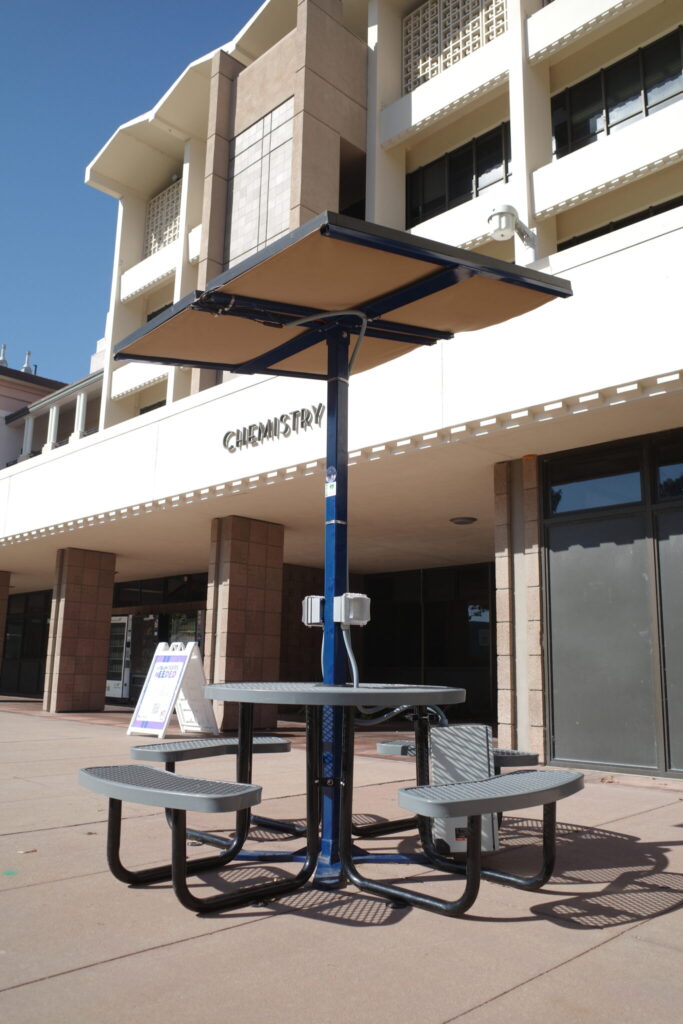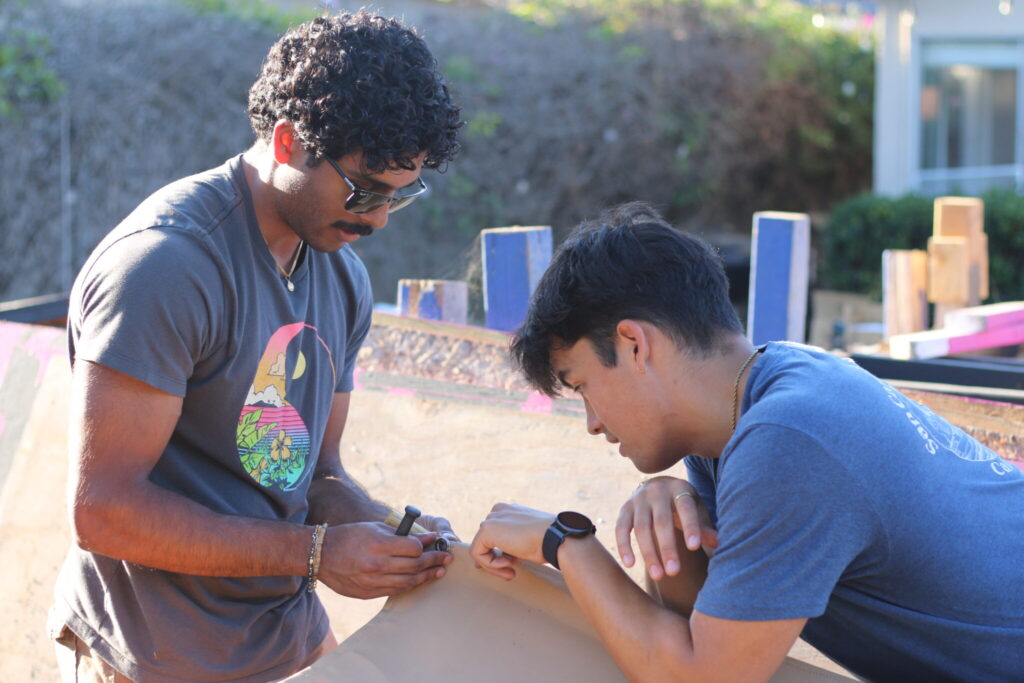
Joy Cheng / Daily Nexus
What started as a packet of old blueprints has now turned into a fully functioning solar-powered table on UC Santa Barbara’s campus — the result of two years of persistence, problem-solving and student-led collaboration through Engineers Without Borders.
The solar table project, designed and assembled by members of UCSB’s Engineers Without Borders (EWB) local team, now sits in front of the Chemistry Building, ready to provide renewable energy and shaded seating for students passing through. For the people who built it, the table represents not just an engineering success but the culmination of teamwork and a belief that students can leave a lasting mark on their campus.
“The best outcome of this project was that around 40 engineers and non-engineers that were part of EWB got hands-on experience with both fabrication and assembly of a real product that helps bring positive change to UCSB’s campus,” Alec Perkins, fourth-year mechanical engineering major and machining lead for the project, said. “They actually saw physical results and the work that they put in come to fruition, creating a device that will hopefully be on campus for at least 10 years.”
The project began in fall of 2023, when EWB members came across an old capstone packet outlining instructions for building a solar-powered table. The following spring, the team received two donated solar panels — given specifically to support the project — and began reimagining how to turn the basic blueprint into a more powerful, durable and campus-ready installation.
“This was based on a previous capstone project,” Arjun Gunda, a fourth-year mechanical engineering major and the project’s design lead and manager, said. “We had found a packet. and it basically detailed out all the instructions for making a solar table, but it was extremely simplified, and it was done with a small team with a small time frame. So we were like, ‘How can we take this existing model and make it so that it can contain more power, supply more power and be a refurbished, campus-implementable model?’”
The team began planning the project nearly two years ago during their sophomore year, dividing responsibilities among design, fabrication and administrative outreach. But turning a student idea into a permanent campus installation came with complications.
“When this started, I was kind of thinking to myself, ‘What is this process going to look like?’ and then I quickly realized, there was no process,” David Bogdanovic, fourth-year mechanical engineering major and the team’s administrative liaison, said. “Campus leadership isn’t really used to students reaching out to them about projects.”
The team applied for and received three Undergraduate Research and Creative Activities grants, as well as funding from the Green Initiative Fund. Beyond securing money, the students had to meet the technical and safety standards required for any permanent structure on campus — a daunting task for a group still learning how to design and build at scale.
“None of us had really built or designed anything of significance at that point in time,” Gunda said. “A big challenge was actually getting the project management laid out and seeing what aspects of this project we needed to designate more people and more time to. And with assembly, we didn’t have any designated place to assemble, so we just did it in our backyard.”
That Isla Vista backyard — shared by Gunda and Bogdanovic — became the hub for most of the project’s hands-on work. Over this past summer, a small group of about six students and mentors met there daily to fabricate and assemble the final components.
Much of the machining and fabrication happened under the guidance of mentors. The team enlisted the help of Kyle Luker, machine shop manager for the UCSB chemistry department, to manufacture parts and help them refine their designs.
“He is such a great resource. He is a lifesaver when it comes to fabrication because we had never worked out the actual requirements on drawings to give to a machinist,” Perkins said. “Having him as a mentor was like no other. We couldn’t have done it without him.”
Another mentor, Marc Osborn, who advises EWB’s local team, helped the group refine the table’s design and improve its electrical efficiency.
“Marc completely rewired the electronics and transformed our system into a high-functioning outlet setup connected efficiently to the solar panels,” Gunda said. “He restructured everything for us, which was a great learning experience and showed how vital mentorship can be. Between Marc and Kyle, I think the biggest takeaway for future projects was knowing which mentors can guide us through different aspects of the process.”
For Bogdanovic, the project’s greatest lesson came from leading a team that was learning on the go.
“When I started, I imagined having a group of about 10 people who already knew what they were doing,” he said. “But I think the whole mission of EWB and what we built our club around is giving people the opportunity to learn — where people can buy into the project from start to finish and learn the skills along the way. None of us really knew what we were doing at first, but that’s how all projects start. Seeing everyone grow and learn together turned what I thought would be a setback into something really rewarding.”
By the first week of September, after two years of work, the table was installed on campus. It takes in 400 watts of solar power at peak sunlight and stores 1,280 watt-hours of capacity — roughly enough to charge 80 iPhones. The table provides DC and AC outlets, as well as USB-C and USB-A ports, making it a functional space for students to study and recharge their devices outdoors.

Gunda and Perkins working on assembling the Solar Table. Photo Courtesy of Arjun Gunda
“In order to get things on campus made by students, you have to be extremely persistent,” Perkins said. “There are many students who begin projects that just fizzle out … this is a case where there was significant management and team effort … It takes some great [advocacy] and persistence in order to get something like this to actually happen.”
That team effort, he added, was what carried the project across the finish line.
“What this club showed me especially was that a project that seemed absolutely too massive for me to ever finish got carried to the finish line because I could rely on my fellow engineers to keep pushing and keep motivating me,” Perkins said.
Gunda said the project’s completion also marked a turning point for the club itself.
“At the time when I joined [the local team] my freshman year, we were a group of three people. We had no resources and didn’t really know anything. The local team didn’t really have any claim to fame other than creek cleanups or volunteering events. But I would say this project was one of the main reasons the team has grown to what it is now — at our peak, we had about 50 people on our team,” Gunda said.
The solar table has already sparked new ideas within Engineers Without Borders. Younger members have begun drafting their own list of campus projects — practical, visible ways to make sustainability part of everyday student life.
“It was great to see how many people were passionate about this project,” Bogdanovic said. “The biggest thing I learned is that if you’re consistent and have a clear vision, you can make things happen.”
With the table now up and running, that lesson is already being passed on — not as a blueprint, but as proof of what students can build when they’re given the chance.
A version of this article appeared on p.12 of the October 30, 2025 edition of the Daily Nexus.




















